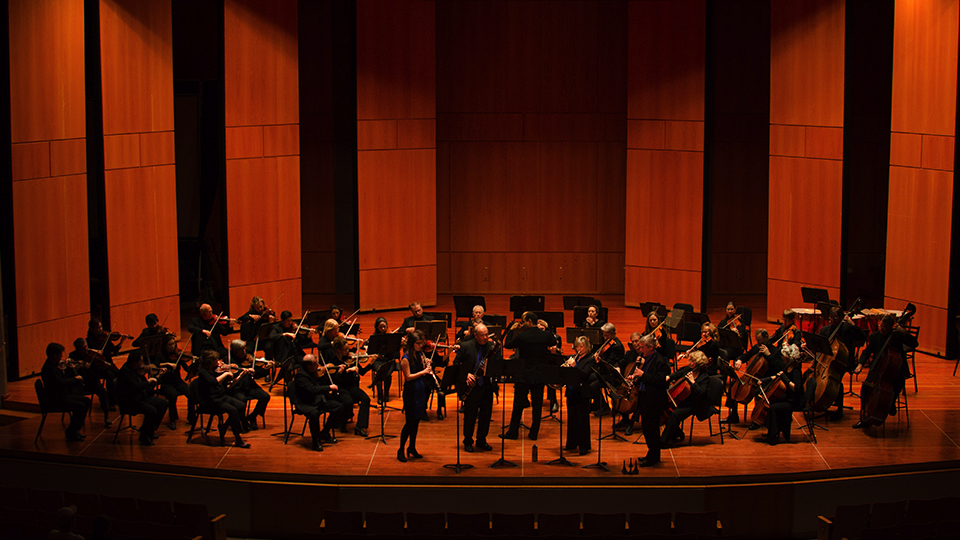A&E
Symphoria getting better and better
By Lucas Phillips '16
January 28, 2016
On Sunday, Jan. 24, Syracuse’s Symphoria presented their “Masterworks: Orchestra Spotlight” concert under the direction of guest conductor Fawzi Haimor. The program featured works by Beethoven and Mozart, and it revealed massive gains in the quality and identity of the orchestra.
Haimor joins Symphoria not long after leaving the Pittsburgh Symphony where he was resident conductor alongside Lawrence Loh, who became Symphoria’s inaugural music director this season. Haimor is in the midst of a long list of appearances including his Finnish debut with Oulu Sinfonia and his Parisian debut with Orchestre de Chambre de Paris.
The program began with Beethoven’s warlike “Coriolan Overture Op. 62” written for Heinrich Joseph van Collin’s 1804 play, Coriolan. Haimor displayed wonderful control over the orchestra, his arms dangling loose at his side during the dramatic silences in the theme. The orchestra displayed its newfound ensemble sound with moments of warmth and strength. The performance added no particularly new interpretation of the work, but was nonetheless crisp and polished.
The real meat of the concert was Mozart’s Sinfonia Concertante for Oboe, Clarinet, Bassoon, Horn and Orchestra. Though the origin of the piece is dubious—most consider it an adaption of a piece Mozart wrote in 1778 for flute, oboe, horn and bassoon—it remains a perennial favorite with its wonderful writing for winds. The piece drew from Symphoria’s section leaders: Jillian Honn (oboe), Allan Kolsky (clarinet), Greg Quick (bassoon) and Julie Bridge (horn). The quartet blended exceptionally well, and credit must be given to Bridge, the one non-reed instrument among them. Her clean, sensitive playing complimented the blend and never overpowered the quieter instruments beside her. There were moments when the tone matching was so strong in the quartet that it was difficult to immediately discern the change when one handed off the melody to another. Honn led the quartet with that special Mozartian playfulness, and guided them with skill during the cadenza in the “Allegro.” A recent appointment to the orchestra, Honn is a senior at Eastman School of Music. It was a hopeful sign to see a young musician adding new life to an aging ensemble.
The orchestra, though playing a supporting role, also sounded good on the Mozart, particularly in the low-end during the reflective moments of the “Adagio.” Symphoria’s strings also sounded strong at the exposed end of the movement. Haimor took a backseat to the soloists, but added his own touch in the orchestral passages. The moment that stood out was his subtle moment of accelerando right at the end of the last movement.
After intermission, the orchestra returned to Beethoven with his oft-overlooked Symphony No. 4 in B-flat major, Op. 60. It was a nice match with the “Overture” because the pieces premiered on the same night in 1807. Haimor started the piece nearly as soon as he’d reached the podium and launched into a tempo slightly faster than is usual. Occasionally, it felt too fast—rushing through some of the more meditative sections of the first movement—but overall, it felt fresh and exciting. The gorgeous second movement (apparently a favorite of composer Hector Berlioz) felt slightly repetitive, Haimor not quite taking advantage of the many iterations of the theme to bring out subtle variations. The third movement reintroduced a brassy, full orchestra sound that, during the pared-back Mozart, felt missing. The orchestra excelled in the last movement with its virtuostic theme, the tempo again faster than usual. As in any good live performance, I noticed new aspects in the “Symphony,” a personal favorite, which I hadn’t before.
I have been watching Symphoria retool and develop over the past four years, and I have never heard them sounding better. They have only recently reclaimed a lush, cohesive sound, especially in the string section. Still, the performance didn’t quite reach an exceptional moment for me. Placing the Mozart after Beethoven on the program made the Sinfonia Concertante feel less exciting than it should have. In the Beethoven Symphony, there was a string rattling moment of sheer power partway through the last movement, but it didn’t feel quite at the right time. Haimor’s control faltered slightly, and the piece never truly hit its noticeable peak. My sense was that now that the orchestra has just regained its cohesion and beauty, it was reluctant to reach for grit and abandon in the most dramatic moments of both Beethoven pieces. However, their turn-around in the last four years has been remarkable and special to witness.
Symphoria will return to campus on May 3, joining Hamilton’s Masterworks Chorale and Hamilton College Choir in a performance of Fauré and Stravinsky.





